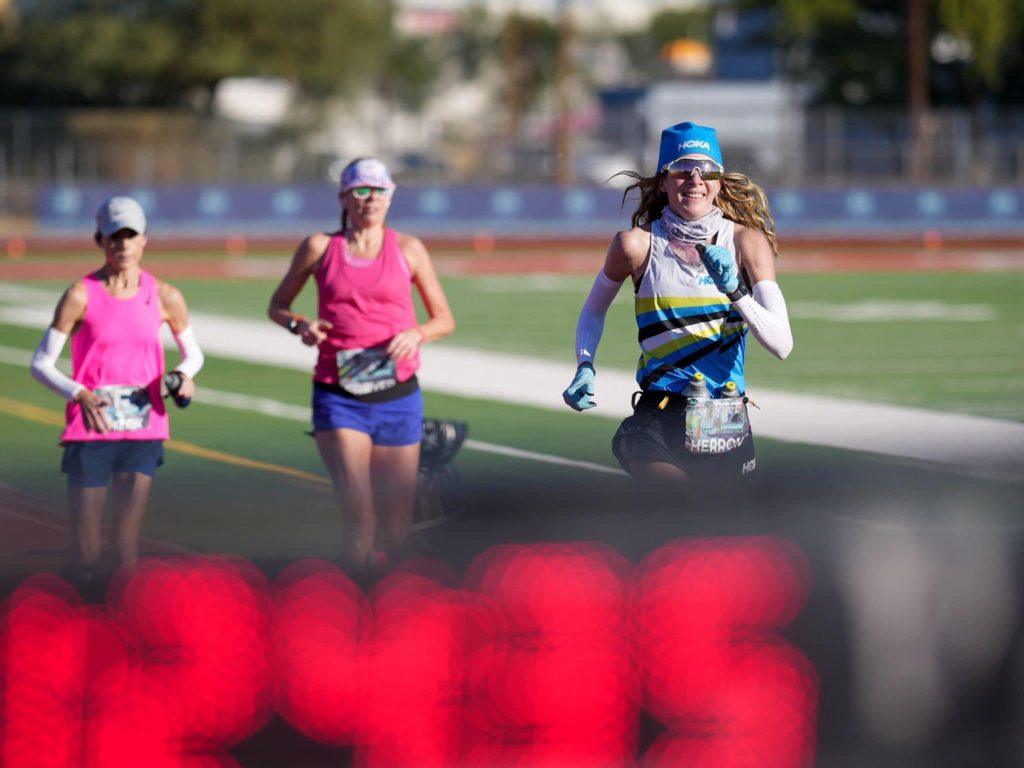I love 24 hour races. In fact, if anyone asks me to describe them, I tell them it’s 24 hours of lap running joy. Well if I’m being honest, it’s about 20 hours of joy, and then 4 hours of awfulness at the end. But the joy definitely outweighs the awfulness, which is why I have kept going back to do them. I do believe though, that if you’re racing them properly, you’ve only got a finite number of 24 hours in you, as I find they take so much out your body. This was going to be my 4th in 4 years (after Crawley, Basel and Bernau) and I thought this would be my final 24 hour swan song for a while, and I’d go out in a blaze of 24 hour PB glory (I was hoping to beat the 129.6 miles I ran at Bernau). And there probably isn’t a better place to run a PB, than at Desert Solstice.
Pre-race
Whilst the world isn’t back to normal, the last few months had felt relatively normal with travel and races, and when the US announced they were opening their borders in November, it never occurred to me that there would be any issues with travel. And then 2 weeks before we were meant to fly, Omicron hit the world. Travel rules changed on a daily basis as countries closed their borders/tightened up their entry restrictions, and every time I got a news alert on my phone, I was expecting it to tell me that the US were banning Brits again. It felt like a return to 2020, when subconsciously you wouldn’t let yourself get excited about anything as you were half expecting it to be cancelled at the last minute. It wasn’t until we had checked in at Heathrow that I finally began to believe DS was going to happen for me.
Race day
Race day arrived, and mainly I was just grateful to be here and excited to be racing on the 24 hour stage. I always feel like the race is the party at the end of a training block, and I was coming into the race on what I felt was the best 6 months of training and racing I’ve ever had, so whatever the outcome, I knew I had loved the process of getting here.
The set-up for DS is as slick as it gets – tents set up for each crew member in lane 3 of the track (I didn’t have to move out my lane when Tom was passing me drinks or gels) and (super clean) toilets also on lane 3 of the track – everything about the race was designed to make things as simple as possible for runners wanting to achieve their best.
The start list was a who’s who of ultra running, with most of the US 24 hour team aiming for qualifying distances for the next World Championships making an appearance, alongside some fast 100 mile runners stepping up in distance. From the word go it felt like a real privilege to be part of the race.
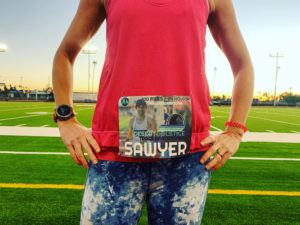
‘Go and be Sarah for 24 hours’ (8am – 12pm)
I have never gone into an ultra with a pace plan, I would hate to run to paces or heart rate. I’m a big believer in running to feel, which is one of the reasons why pacing is one of my strengths. However, I did think as I was aiming for a target here, I should have some kind of pace plan, and I did go as far as pulling together a pacing spreadsheet. However, I knew this would spoil my enjoyment of running, so I ripped the spreadsheet up and took the best advice from my coach James Stewart who said to me ‘go and be Sarah for 24 hours’ – wear pink, smile lots and if you’re having a good day the result will take care of itself.
So that’s exactly what I did and the first few hours felt like an absolute perfect dream. I knew I was the slowest runner by far on the track and I was lapped umpteen times, but it didn’t bother me in the slightest as I was in my own little happy world. I have an 8 hour playlist full of songs that are always guaranteed to make me smile that I always play in the first few hours of an ultra, and that, combined with the December Arizona sunshine, and the fact I was running amongst some of the best ultra runners in the world, gave me the perfect start to the race.
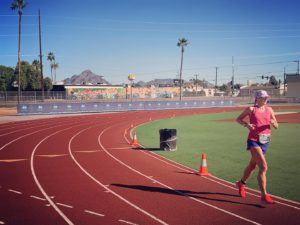
It’s getting hot in here (12pm – 4pm)
There wasn’t one overriding thing that went wrong for me at DS, more a culmination of various things. The weather in Phoenix on race day only reached a high of 20 degrees, and whilst this was a lot hotter than anything I’d run in in the UK in months, I’d done 3 weeks of heat acclimation prior to the race as I know I respond well to it, and the warmer temperatures didn’t affect me at all. What I did notice though was that I was drinking a lot more than usual. Back home, I regularly practice my race nutrition in long training runs so there’s no surprises on race day, however I am less good at practicing with my race hydration. I hate running with a rucksack, so I’ll go out on a 26-30 mile training run with just a 500ml bottle of Mountain Fuel in my Naked belt. Therefore my stomach struggled with all the extra liquid, and a couple of times in the afternoon I threw up everything I’d just drunk. The worst thing about 24 hour races is there’s nowhere to be discreetly sick (well I guess there’s the toilet, but going to the toilet wastes time!) so I just threw up over myself as I knew it would be pure liquid, and then grabbed a baby wipe from Tom the next time I ran past him – don’t let anyone ever tell you ultra running isn’t a glamorous sport?!
Race mistake one – I need to practice taking more liquid on in training runs (even if it means training with a rucksack!).
It was also in the early afternoon that I started to feel really really tired. I have never suffered from jet lag that badly when I’ve been flying west, however I guess I’ve never asked my body to run for 24 hours less than 2 days after arriving in the US. I’m always in bed by 9pm at home, so at 2/3pm my body was thinking it was night time and I could easily have had a little sleep by the side of the track. I don’t drink coffee in day to day life, so I always have emergency caffeine for 16+ hours in, however I needed to break into the emergency caffeine after just 6 hours. This meant that whilst I got an instant pick-me-up then, later in the race I just felt flat and tired.
Race mistake two – I should have just tried to push through the tiredness in the afternoon and saved the caffeine for later.
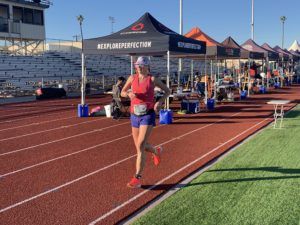
Living my best (track) life (4pm – 8pm)
I hit 50 miles in 8:17 hours, which is exactly where I’d have wanted it to be, but most importantly I was feeling really good and it felt like the early easy miles had set me up nicely for the rest of the race. The caffeine had picked me up and my stomach had settled. By taking the first 50 miles easy I was confident I could hit 100 miles in around 17 hours, which had been around my 100 mile split for my last two 24 hour races. The temperatures dropped quickly as soon as the sun went down, and I added a top and gloves, but as long as I kept moving well the temperatures were perfect and this was probably my strongest section of the race.
I was sticking to my tried and tested nutrition plan of a MF jelly or gel every 30 minutes, and then every 2 hours taking either a pot of custard or a MF recovery shake. When the temperatures dropped and because I’d been struggling to take on liquid earlier, my drink consumption also dropped a lot. I always aim for 300 calories an hour, of which about a third of these will be from drinks, and in hindsight, because I wasn’t drinking much, I wasn’t taking anywhere near enough calories/carbs on. Whilst it didn’t affect my running immediately at the time, it did set off a calorie deficit downward spiral into the slog the race became.
Race mistake three – if my original nutrition plan isn’t working I need to adapt it on the go to make sure I’m still getting a minimum of 300 calories/65 grams an hour in.
Records falling (8pm – 11pm)
I was still feeling good though at 12 hours and felt like I was on track for 130+ miles. I had changed my mindset going into this race and told myself I was running a 130+ mile race, as opposed to a 24 hour race, as previously when I’ve got to 100 miles in a 24 hour race I find my motivation starts to wane. I hadn’t struggled with the 153 miles of Spartathlon though, so I hoped that by telling myself the race was 130+ miles long, I’d avoid that post-100 mile slump.
Mentally this worked, and it felt much easier when I got to 80 miles and I could tell myself I’d ‘just’ got 50ish miles to go, and at this point I had comfortably over 10 hours to run 50 miles (12 minute mile pace).
There was also so much going on around me during this section (Camille breaking her own 100 mile record in 13:21, David Laney running 12:34 for 100 miles, Pam Smith breaking numerous age group records, and Nick Coury still running sub 8 minute mile pace enroute to a new American 24 hour record) that the hours and miles still felt like they were ticking by nicely for me.
The wheels fall off (11pm – the end)
Looking back on my Strava splits, it seems like the wheels started to fall off at about mile 90. I was tired and had no energy and felt totally flat. Normally I’m still (relatively) skipping round the track after 16 hours, high on lap running life, here my pace massively slowed down to 12 minute mile pace at best and I was even taking walk breaks. I was also mentally finding it a real slog – previously I’ve never been able to understand why people don’t want to run around a track for 24 hours, whereas this time I was definitely questioning what I was doing!
The organisers and volunteers celebrated everyone passing through 100 miles, and whilst I know a 100 mile split of 18:08 isn’t a bad time for some people, it was so far off my best, it definitely didn’t deserve celebrating! On top of it being my slowest 100 for 4 years, I’d also executed it really poorly – I know to run a good 100, the second half should be no more than an hour slower than the first, here I faded so badly in the second half that it took 1:50 hours longer than the first half.
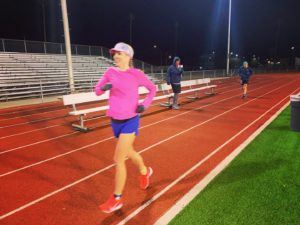
After passing 100 miles, I still aimed to be on the track for the full 24 hours, even if I was going to be walking the majority of it, as I worked out I could reach 120+ miles, which again would be way off my best, but gave me something to aim for.
However, I hadn’t factored in how cold it was overnight and how much my body temperature would drop when I was moving so slowly. We tried every option to get me warm – I put every item of clothing I had with me on (two tops, hoodie, leggings, gloves, even the DS hoodie they’d given me pre-race!) and tried hot drinks, but nothing worked and I made the decision to call it a day with just over 100 miles on the clock.
Race mistake four – be better prepared for all weather eventualities in case I’m moving pitifully slowly and the race becomes a slog.
There were no regrets and no excuses, I set myself a high target, I gave my best on the day, made some mistakes which I take full responsibility for, and ultimately I fell way short of my targets.
Despite my very sub standard performance, Desert Solstice was still a dream race to be a part of. I absolutely loved the months of training leading up to it and I learnt so much on the day, so whilst on paper the result is a failure, I can take so many positives from the whole experience which is a different kind of success in my book. For now though, I’m taking a hiatus from tracks and looking forward to roads, tarmac and canals in 2022!
Thanks as always to James for the the super coaching and the happiest 13 months of training I’ve ever had, and to Tom for standing trackside yet again handing me bottles of Mountain Fuel and pots of custard – at least he’s going to get some slightly more interesting crewing gigs next year!
